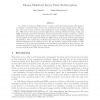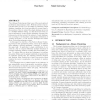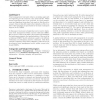CCS
2007
ACM
14 years 1 months ago
2007
ACM
We construct an Attribute-Based Encryption (ABE) scheme that allows a user’s private key to be expressed in terms of any access formula over attributes. Previous ABE schemes wer...
CCS
2007
ACM
14 years 1 months ago
2007
ACM
In a proxy re-encryption (PRE) scheme, a proxy is given special information that allows it to translate a ciphertext under one key into a ciphertext of the same message under a di...
CCS
2007
ACM
14 years 1 months ago
2007
ACM
A group key agreement protocol (GKA) allows a set of players to establish a shared secret key which can be used to secure a subsequent communication. Several efficient constantrou...
CCS
2007
ACM
14 years 1 months ago
2007
ACM
Where do most vulnerabilities occur in software? Our Vulture tool automatically mines existing vulnerability databases and version archives to map past vulnerabilities to componen...
CCS
2007
ACM
14 years 1 months ago
2007
ACM
CCS
2007
ACM
14 years 1 months ago
2007
ACM
In existing RBAC literature, administrative privileges are inherited just like ordinary user privileges. We argue that from a security viewpoint this is too restrictive, and we be...
CCS
2007
ACM
14 years 1 months ago
2007
ACM
Stateful, in-depth, inline traffic analysis for intrusion detection and prevention is growing increasingly more difficult as the data rates of modern networks rise. Yet it remai...
CCS
2007
ACM
14 years 1 months ago
2007
ACM
A high-level security policy states an overall safety requirement for a sensitive task. One example of a high-level security policy is a separation of duty policy, which requires ...
CCS
2007
ACM
14 years 1 months ago
2007
ACM
CCS
2007
ACM
14 years 1 months ago
2007
ACM
Trust management represents today a promising approach for supporting access control in open environments. While several approaches have been proposed for trust management and sig...




